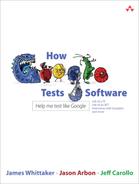Preface
Software development is hard. Testing that software is hard, too. And when you talk about development and testing at the scale of the entire web, you are talking about Google. If you are interested in how one of the biggest names in the Internet handles such large-scale testing, then you have found the right book.
Google tests and releases hundreds of millions of lines of code distributed across millions of source files daily. Billions of build actions prompt millions of automated tests to run across hundreds of thousands of browser instances daily. Operating systems are built, tested, and released within the bounds of a single calendar year. Browsers are built daily. Web applications are released at near continuous pace. In 2011, 100 features of Google+ were released over a 100-day period.
This is Google scale and Google speed—the scale of the Web itself—and this is the testing solution described in this book. We reveal how this infrastructure was conceived, implemented, and maintained. We introduce the reader to the many people who were instrumental in developing both the concepts and the implementation and we describe the infrastructure that it takes to pull it off.
But it wasn’t always this way. The route Google took to get where it is today is just as interesting as the technology we use to test. Turn the clock back six years and Google was more like other companies we once worked for: Test was a discipline off the mainstream. Its practitioners were under-appreciated and over-worked. It was a largely manual process and people who were good at automating it were quickly absorbed into development where they could be more “impactful.” The founding team of what Google calls “Engineering Productivity” has to overcome bias against testing and a company culture that favored heroic effort over engineering rigor. As it stands today, Google testers are paid on the same scale as developers with equivalent bonuses and promotion velocity. The fact that testers succeeded and that this culture has lived on through significant company growth (in terms of products, variety, and revenue) and structural reorganizations should be encouraging to companies following in Google’s footsteps. Testing can be done right and it can be appreciated by product teams and company executives alike.
As more and more companies find their fortunes and futures on the Web, testing technology and organizational structure as described in this book might become more prevalent. If so, consider this the playbook for how to get there.
This Google testing playbook is organized according to the roles involved. In the first section, we discuss all the roles and introduce all the concepts, processes, and intricacies of the Google quality processes. This section is a must read.
The chapters can be read in any order whatsoever. We first cover the SET or software engineer in test role because this is where modern Google testing began. The SET is a technical tester and the material in that chapter is suitably technical but at a high enough level that anyone can grasp the main concepts. The SET chapter is followed by a chapter covering the other primary testing role, that of the TE or test engineer. This is a big chapter because the TE’s job is broad and Google TEs cover a lot of ground during the product cycle. This is a role many traditional testers find familiar, and we imagine it will be the most widely read section of the book because it applies to the broadest practitioner audience.
The balance of the book is about test management and interviews with key Googlers who either played a part in the history of Google test or are key players on key Google products. These interviews will likely be of interest to anyone who is trying to develop Google-like testing processes or teams.
There is a final chapter that really should not be missed by any interested reader. James Whittaker gives insight into how Google testing is still evolving and he makes some predictions about where Google and the industry at large are heading test-wise. We believe many readers will find it insightful and some might even find it shocking.
A Note About Figures
Due to the complexity of the topics discussed and the graphical nature of the Internet, some figures from Chapter 3 in this book are very detailed and are intended only to provide a high-level view of concepts. Those figures are representational and not intended to be read in detail. If you prefer to view these figures on your computer, you can download them at www.informit.com/title/9780321803023.
